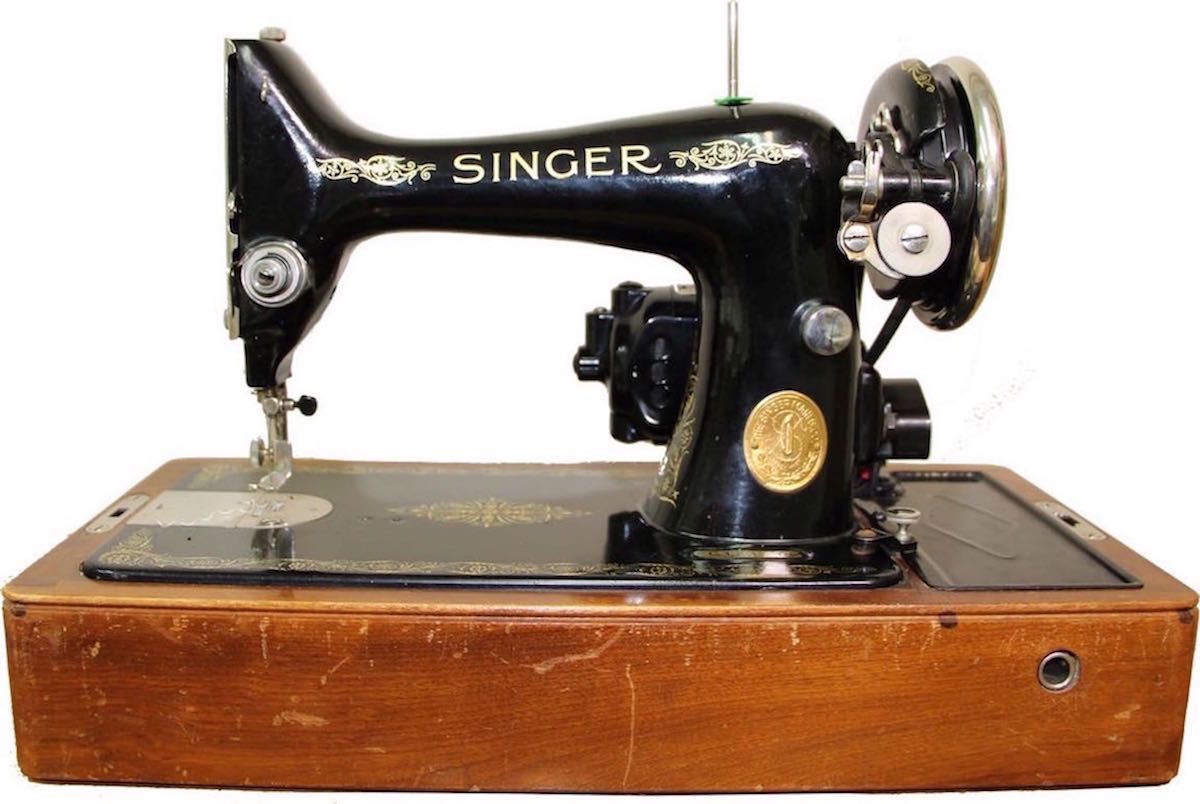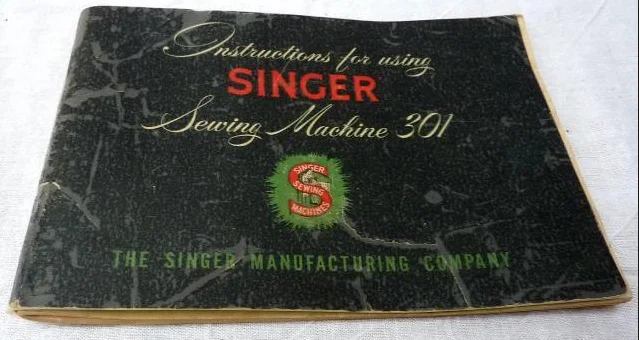
Vintage Sewing Machine Blog
Vintage Sewing Machine Blogs
Here are vintage sewing machine blogs that you may have missed. Happy Reading!
If you find these blogs useful you may want to consider purchasing my eBooks about buying or selling Vintage Sewing Machines. Click here if you are interested in learning about how to buy, restore and use a machine. Click here if you are interested in learning how to sell your machine for a higher price without wasting time and effort.
Please note that Chatterbox Quilts does not buy or sell or provide free evaluations on vintage sewing machines.
"This is the last vintage sewing machine that I'm going to buy". I know I have said it before, but I always mean it... until I see that vintage sewing machine that I just have to have!
What did I add to my collection this time? A Singer 15-97 with RAF decals and a special badge.
Once I confirmed that the sewing machine was still available, I jumped in the car with my cash in hand. I have an evaluation kit that I take with me when I’m looking at purchasing a “new” vintage sewing machine. It helps me make sure that a "great deal" is also a working machine. I was in such a hurry, that I almost forgot to take it with me, but remembered and grabbed it just before I jumped in the car. I was so glad I did! I have a link in the blog to a free Evaluation Kit List so that you can put together your own kit for your next vintage sewing machine shopping excursion.
The best thing about owning a vintage sewing machine is… no, not stitching with it, which is pretty amazing, but repairing and maintaining it. Unlike modern machines, vintage sewing machines need a bit more TLC, but I love this part of working with my machines.
I feel a deep connection with my machine and love learning all its little quirks. This connection is deepened when I clean it, make simple repairs, and oil it. I get a real feeling for how to get the best from my vintage sewing machine and learn when it needs a little maintenance or oiling. (I’m thirsty, feed me).
One of the most important things I learned from my early experiences was that you need to be able to assess a machine knowledgeably when considering a purchase to ensure that you pay a fair price for it. The best deals are when someone is selling a machine privately and you usually do not have a lot of time to look the machine over. You really need to know about the model you are considering and ensure all the important parts are functional, and, if they aren’t, that you will be able to fix them. You don’t want to miss out on a good deal, but you also want to ensure that you are getting a functional machine.
The owner's manual is a critical source of information about how to use, maintain and even repair your sewing machine. You’ll need the manual to learn how to thread the machine, wind the bobbin and use the machine properly. The manual explains what would’ve originally been included in the machine purchase. It details the attachments that would’ve been sold with the machine.
One of the members of my Chatterbox Quilts Facebook group needed some help in threading her Singer 201 sewing machine, so I created a short video on how to do this.
If you are looking for a really great deal and you are comfortable in your ability to assess a vintage sewing machine, then I recommend that you buy local. Yes, you can buy a vintage sewing machine from eBay, but sewing machines are heavy so even if you find a good deal online you are going to have to pay some hefty shipping charges to get it to your house. You have a better chance of getting a good deal on a vintage sewing machine if you find one locally that is underpriced due to its condition. Vintage sewing machines that needs some tender loving care are your best bet.
I’ve compiled all my favourite websites into a FREE printable download, Vintage Sewing Machine Websites, that I find useful for this purpose. Print it out right away so you’ll have it handy when you need to refer to it.
I've created the Pricing Guide for Vintage Sewing Machines that will help you answer the question, “Is this a good price to pay for a vintage sewing machine?”. This PDF download is full of information to help you determine what price you should pay when you find your perfect machine(s). While I refer to SINGER® sewing machines in this FREE guide, this information is applicable to any brand of vintage sewing machine.
I often hear people say that a treadle machine doesn't work, when often there is only one small, but significant, part that would enable the machine to run: the belt. Most of the belts on these machines were made of leather, which, over time, would wear, become brittle and eventually break, rendering the machine "unuseable". This is a simple and inexpensive fix as new treadle belts can be purchased in either leather or rubber, for just a few dollars. Put on the new belt and you're ready to start stitching.
While I never really notice much difference in the attachments on my vintage Singer sewing machines, there is a definite and obvious difference in those on my Singer 66. To find out what I'm talking about, watch the video below or on my YouTube channel.
Hello and thanks for joining me for Telecast Thursday! This week I'll be explaining why I added another Singer sewing machine to my stable of vintage machines. I know, I know, I'm not supposed to do this, but I did sell one of my other, larger machines, so I definitely had room to add this one. It's a portable hand crank model, so no, well minimal, floor space will be taken up by this machine.
Before we had sewing machines that could stitch out hundreds, maybe even thousands, of decorative stitches, you had to use an attachment to create anything other than a straight stitch. One of these attachments was the two thread embroidery attachment made for Singer sewing machines. While these are cool little machines, it's very hard to find them now. I was fortunate enough to find one mixed in with a lot of Singer attachments and snapped it up right away!
I pulled out one of my "to do" projects and thought that I had better get it done! I had set these fabrics aside about two years ago to create a project from Turning Twenty - Simply Sashed and that was about as far as I got with this pattern. What got me finally started on making this quilt? My Singer 66 Red Eye treadle sewing machine. Watch my Youtube video on how I acquired this machine.
I got some good deals on several vintage Singer models, including a 99 and a 128. While there I noticed this older sewing machine that wasn't in great shape (my hubby thought it was ugly and not worth his attention), but something about it caught my eye. I went back to pick up another machine and this poor mistreated Frister & Rossman sewing machine was still there and this time I bought it. It isn't pretty, but there was just something about it that called out to me and home it came.
I almost forgot to tell you about my other machine acquisition: a Singer 128 with La Vencedora decals. While I already have a Singer 128, I was drawn to this machine due to its beautiful intricate decals. I've seen other models of this machine before in other venues, but never have I seen one in such good condition and at such a great price!
I had an interesting comment from someone who was concerned about free motion quilting on their sewing machine because they were afraid of damaging their wonderful vintage machine. This person did eventually do some quilting and was presently surprised at how well it worked. I was glad she took the chance because I know how sturdy these older machines are and I would have no qualms about using them to sew in really tough conditions.
I typically purchase my machines from ads I see on kijiji and you know how difficult it can be to tell what model the poster is selling from the tiny pictures that are on the site. I can usually figure out which model of Singer I'm going out to see, but this one almost stumped me. While I thought it was a version of the popular Singer 15 model, it turned out to be something else, a Singer 115. I'll show you how to tell the difference so you won't be fooled too.
Your vintage sewing machine may've come with some strange looking feet, or attachments, as they were referred to in the machine manuals. While some of these are quite similar to modern feet, such as the regular pressing foot, others, such as the ruffler, appear more exotic. Some sewists have trouble stitching with these more complicated feet and one of the reasons may be that the foot needs to be oiled. Yes, feet sometimes do need to be oiled!
Usually when I'm looking for a vintage sewing machine I have a list of requirements: wires in good shape, runs okay, decals not worn, etc. I recently bought a Singer 128 sewing machine that didn't have any of these qualifications. Why did I buy a sewing machine that had wiring so bad I couldn't even tell if it ran? Watch the video below to find out.
You may see this type of table at garage sales and it looks like a regular card table, but there is a slight difference: there's a cut-out in the top of it.
While older Singer sewing machines came with lots of attachments, the Singer 500 came with even more! The iconic green attachment box with the red Singer logo was replaced by a two tier hard plastic accessory box, similar to the one that was included with the Singer 401 machine. I especially like that a straight stitch needle plate is included with the machine, as well as the zig zag one.
This week I'm thrilled to show you my latest vintage sewing machine - the Singer 500, commonly called the Rocketeer. I've had my eye out for one of these for some time, but could never find just the right one - until now. This machine is quite different from my previous machines and its iconic styling makes it instantly recognizable.























Most people who are looking to buy a vintage sewing machine are doing it out of the love of these unique and attractive machines. Do a little homework, apply some elbow grease, and display your machine effectively and you will sell your machine for the best price.